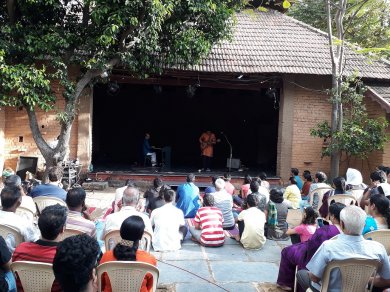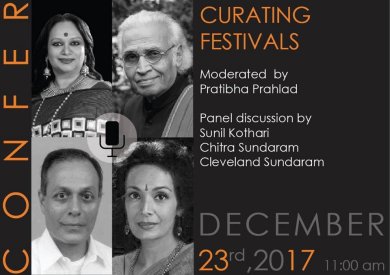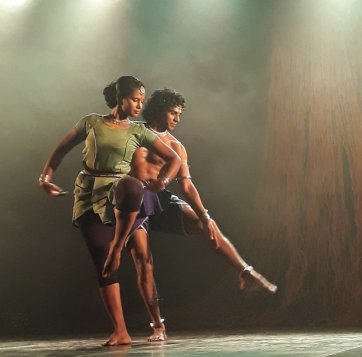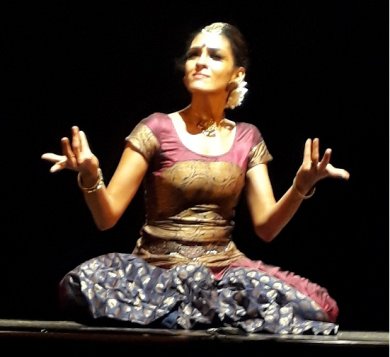
|   |

|   |
 e-mail: sunilkothari1933@gmail.com If it is December, it must be Madras/Chennai Photos: Dr. Sunil Kothari January 14, 2018 In the early seventies in Mumbai at Empire cinema, I had seen a Hollywood film titled 'If it is Tuesday, it must be Belgium.' It fits in well for my footloose and fancy free wanderings. Hence the title of this article. Way back in 1970 December on my return from a year long travels and considerable long stay in London, I had gone with Chandralekha to the early morning session at The Music Academy to attend a lec-dem by Dr V.Raghavan explaining subtle nuances of abhinaya by the legendary Balasaraswati. At that time there was a shamiana and lec dems were held under a pandal. Listening to Bala's exquisite singing, one was under her spell. She was a big built woman and used to dress in a simple saree, no makeup and would perform abhinaya padam, which Dr. V. Raghavan would explain in advance, mentioning raga and tala and gist of the song. It was quite an experience. It indeed opened up for someone like me a new way of looking at dance. In Chennai with predominant Tamil speaking community and the rasikas and connoisseurs the songs were understood and therefore also the subtleties of abhinaya along with sanchari bhavas, spontaneous improvisations. But in case of Bala, her manodharma, imaginative interpretations were not what everyone could understand and relish. Therefore Dr. V.Raghavan's explanations in English helped non Tamil speaking rasikas a lot. After the lec-dems, many a times, Chandralekha would be asked by Bala to join her for morning breakfast and coffee. It was indeed a privilege to join them. Chandra was learning from Kanchipuram Elappa Pillai, who accompanied Bala for nattuvangam. Bala and Chandra were good friends. Chandra introduced me to Bala and since then one had become a devotee of Bala. So December meant Chennai. The Margazhi month then offered excellent music by stalwarts like Ariyakudi Ramanuja Iynegar, Mudikondan, Semmangudi Srinivasa Iyer, DK Pattammal, M.S. Subbulakshmi and others. Chandra was at that time staying on Elliots Road, now Radhakrishnan Salai. Her neighbor was Vidya Shankar, a vastly gifted veena player. Behind her house was Dr. V. Raghavan's house. Since I stayed with Chandra and attended major classical music performances, I came to know Dr. Raghavan well. That was a blessing. Because when I undertook my researches in 1975 for dance drama traditions of Kuchipudi, Bhagavatamela Nataka and Kuravanji with special reference to Rasa Theory as expounded in Bharata's Natyashastra, his generous guidance was a boon. When he saw my industry and deep involvement, he gave me several books with English translations to study, in particular about Bhakti literature. The die was cast. Since then except when I was away abroad, I never missed Margazhi celebrations in Chennai in December. Known as December 'season' many, like me, headed for Chennai planning well in advance to travel from Mumbai not to miss the major music and dance performances. It was a great learning for someone like me, who was exposed to dance conferences in Mumbai where at annual Sur Singar Samsad's Swami Haridas Sammelan I was exposed to Hindustani music and predominantly classical Kathak dance. There were also Bharatanatyam performances by Kamala Lakshman, Vyjayantimala, Balasaraswati. However the morning sessions at The Music Academy were very educative. There was vidvat, knowledge and technical discussions that threw lot of light on the musical forms. Over the years, now that we are in 2017 and 2018, the scene has changed a lot. The proliferation of more than 2000 dance and music events spread over December and January, with more than 50 sabhas holding dance and music events, one is saddled with selecting what one wants to see as so many events are held parallel. Therefore one has to forego two, three major performances and settle for the choice one has to make. 'Sabha hopping' has become routine as one can catch up on morning and noon events, which are free, and be ready for major evening events. Two major conferences are held in December. Krishna Gana Sabha has been holding Natya Kala Conference since 1980 and it has been a major conference with its morning sessions, rasikas converging at T. Nagar where the sabha's auditorium is. Audiences start coming by 7am as the religious discourse is held from 7am till 9am. The Natya Kala Conference starts half hour later. An Nritya Choodamani awardee is selected to convene the five day long morning conference from 26th December till 30th December. For the first three years, Dr. Padma Subrahmanyam was the convener and it set the bench mark for learned discourses on dance. In the evening classical dance performances are held. Now this is the 37th year of Natya Kala Conference. Srinidhi Chidambaram was the convener for the last two years and she selected the theme of Sringaram and its ramification in major eight classical dance forms. The other conference hosted for the last 17 years by Kartik Fine Arts is titled Natya Darshan and it was held at Bharatiya Vidya Bhavan for three days from 22nd till 24th December. The convener was architect and Bharatanatyam dancer Krithika Subrahmanian. She titled it Now or Never. I was invited to be on a panel on 'Curating dance festivals' along with Cleveland Sundaram from USA and Chitra Sundaram from London. Prathibha Prahlad, a Bharatanatyam dancer and Director of the Delhi International Arts Festival, was the moderator.  Anil Srinivasan and Prasanna Anita Ratnam, the Managing Editor of Narthaki.com, curated 'Awakening' on 23rd December at Chandralekha's Spaces featuring piano recital by Anil Srinivasan and Guitar by Prasanna from 7am in the morning. Also breakfast with hot cup of coffee was arranged in the spacious open ground. The Chandra Mandal theatre was full by 7am; rasikas also sat on carpets on the ground, relishing the classical Carnatic music fare, applauding the highlights and the ragas they loved. Situated on the Elliots Beach Rd on sea front, Spaces has become a favourite venue for dancers and musicians to hold performances. Sadanand Menon, who is the trustee, looks after Spaces. No fees are charged except the arrangements for chairs and lighting have to be taken care of by artists who wish to book the theatre. It is one of the finest venues with trees planted, the morning sun filtering through the branches, gentle sea breeze blowing. The ambience is exquisite for morning music sessions. The musical notes on piano and guitar by these two brilliant musicians filled the air and created magic. Diaries published by Arangham were for sale with the sales money donated to an institution for blind. Apart from what the season has to offer, we discuss the important issue of a National Theatre to be finalized in New Delhi at Indira Gandhi National Centre on lines of Esplanade (Singapore), Barbican (London) and Brooklyn Academy of Music (New York). It is a question of Government will and philanthropist coming forward like Jamshed Bhabha in Mumbai or someone like Kiran Nadar in Delhi who has built a museum and art gallery in Delhi of international standards. Ashok Vajpeyi, Managing Trustee of Raza Foundation, who has built Bharat Bhavan in Bhopal, has vision to have a theatre with international standards. At present we have only National Centre for the Performing Arts (NCPA) in Mumbai which meets international standards. Surely, the Capital can afford to have a world class theatre. Artists and connoisseurs troop in, joining in discussions related to art matters. When the Government finally selects the new Director of Kalakshetra Foundation, one can assist him or her to get the auditorium built on a war footing. The Annual Kalakshetra Festival is not held as the other theatre is also not functioning after the cyclone which blew off the roof.  Curating Festivals
The Natya Darshan panel discussion on 'Curating festivals' was to start at 11am so we rushed to Bharatiya Vidya Bhavan. Krithika had taken a stand that 'audiences must pay to watch the dance and dancers must be paid to perform.' Since all these years the morning admission has been free, audiences find it odd to buy passes (entry for each day Rs 300). However, Krithika wanted to set an example that the entry for the conference must be with fees for discussion sessions and also performances in the evening. One looks forward to seeing the trend of paying for watching dance performances. Since rasikas visit Chennai in large numbers, evening sabha programs are ticketed. In Mumbai, NCPA events are ticketed. It is only in New Delhi that dancers suffer a lot. No one pays for dance performances, which is quite a shame. Prathibha Prahlad gave background of her experiences of curating festivals in Bangalore under the aegis of her institution Prasiddha Foundation. She spoke about her experience of holding Hampi Festival for few years. And once again Karnataka Government has requested her to arrange dance festivals at three venues. Since Prathibha moved to Delhi, she approached various agencies like ICCR, IGNCA, SNA, Lalit Kala Akademi, Sahitya Akademi, National Museum, to hold an international Arts Festival. Somewhere a beginning had to be made. She approached several agencies to come forward and under one umbrella mount the ten day festival at several venues all over the capital. With a limited staff working round the clock and personal initiative and contacts, Prathibha has proved that such a festival can be organized. That this was the 11th edition of DIAF shows how she has succeeded. Of course it has taken almost more than six years to get it established. Now it is on sound footing and various countries from abroad are applying online to send their troupes to Delhi. Cleveland Sundaram, as he is known, gave in brief how thirty years ago he started the Cleveland festival. The Indian Diaspora, lovers of classical Carnatic music and dance welcomed his initiative and in spite of very little response in the beginning, persuading people, requesting artists from India to visit Cleveland and perform before the Indian Diaspora audiences, collecting funds over several years of hard work, not expecting anything in return, Sundaram has built the festival on a sound footing and people and artists from India look forward to visiting the festival. Everything is done on a voluntary basis, accommodation, local transport, arrangements for food, international travels and today Cleveland has the largest audience for classical music and dance in the US. The local young dancers and musicians are enthused to pursue classical music and dance with competitions and exposure to the great artists from India. It is one of the finest stories of success. Chitra Sundaram from London spoke of what British Government offers for promoting arts to Diaspora. In the process they set a trend for innovative choreographies, at the same time respecting the traditions of Indian classical dance and music. The two institutions, Akademi run by Mira Kaushik in London and Sampad run by Piali Ray in Birmingham, have created history. Artists have created new works based upon tradition and also seen that classical arts are no more called ethnic but are accepted as classical arts of India. The emergence of dancer choreographer Akram Khan and in recent years Aakash Odedra has changed the scene. Young generation of dancers is encouraged through financial grants. Though the pie is small and there are many claimants, the results have been encouraging. With consistent hard work and persistence the Indian Diaspora community has made a mark. The two major dance conferences of Navadisha have been extremely successful which have placed Indian dance forms as they have developed in UK. Contributions of Shobana Jeyasingh, Akram Khan, Mavin Khoo, Sonia Sabri, Nahid Siddiqui, Pratap Pawar, and institution like Bharatiya Vidya Bhavan have been immense. Kathak as a classical dance form along with Bharatanatyam is to the fore. And from India, Aditi Mangaldas and Daksha Sheth have created their own following among British audiences. In mid eighties Government of India had under the guidance and vision of Pupul Jaykar started the Festivals of India abroad in USA ,USSR, France, and UK which were met with great success, building bridges of understanding between two cultures. Indian Council for Cultural Relations had played a major role. During my talk I mentioned that even today only the Government of India is the biggest financial agency which can mount such mega events abroad. Festivals like Avignon projected Indian arts with special focus on India. I also mentioned that ultimately it was excellence which matters for mainstream participation of Indian artists. National treasures like Kelucharan Mohapatra, Vempati Chinna Satyam, Birju Maharaj, Chandralekha and theatre director Ratan Thiyam made it to mainstream, whereas divas like Yamini Krishnamurty, Uma Sharma, Sonal Mansingh made it through ICCR. Private impresario like Thomas Erdos in France presented consistently for a quarter of a century, dancers like Alarmel Valli and Madhavi Mudgal who also made name internationally. The festival directors look out for excellence and those who have it, make it to mainstream. Today the scene has changed. Unless they have that excellence, dancers find it difficult to get chances in mainstream scenario. Most dancers perform in USA and elsewhere for Indian Diaspora audiences. Curating festivals is a difficult task and needs lots of financial support and sponsors, and a vision to match the international standards.  Samudra  Rukmini Vijayakumar Natya Darshan conference as visualized by Krithika Subrahmanian had several new features though the concept of managing time seems to have taken a back seat with sessions going on endlessly. Sparks for dancers under ten, what is required for 'Branding', Revivals curated by Anita Ratnam giving English poems to dancers to work with film director, ad agency person, musician to create new works, Kucha Pecha, a Japanese term for presentation of concepts, how to win audiences. New works like Sanjukta Wagh's 'Jheeni' using Kabir's and Dalit poets' poems with excellent vocal music, instrumental music and Kathak, Refugees issues as projected in Agathi by Apsara Arts from Singapore, Samudra artists from Kerala with their physically energetic dance including martial art Kalaripayattu, classical Bharatanatyam visualized by Usha RK on theme of vehicles of Gods, solo by Rukmini Vijayakumar, and contemporary one hour long work by Attakkalari troupe from Bangalore. The audience responses were mixed. Jheeni received uniform approbation, whereas Agathi posed problems for appreciation in absence of choreographer's note. It was only in post performance discussion that many points like use of poems written by refugee children in Toronto, use of Subramania Bharathi's songs used in films, their relevance, and the echoes of contemporary political issues of Rohingya refugees, themes inspired from Sri Lankan refugees et al needed to be given as background for the production. Some people did not like the use of film songs as they did not see the context, whereas the scenes of refugees crossing in a boat, a child dying, throwing away its corpse in sea were extremely well performed. Samudra group from Kerala danced marvelously with raw energy. They need some sound feedback for how to channelize their energies. Rukmini Vijayakumar explored complex emotional situation through the metaphor of love of gopi for Krishna who once he went away to Dwaraka, did not look back and when gopi went to see him, the old love seemed to have faded. The depiction was heartbreaking for the nayika who had to accept such realities, but a bit overdone. Kucha Pecha required better technical support. Despite such technical glitches, Nalini's presentation of Indian Heritage Museum in Singapore was most successful as it explained why one should go to the museum and how to look at the display and aim of the presentation of artifacts to evoke history. I have been there twice and would recommend readers /rasikas not to miss visiting it when in Singapore.  Dr. Sunil Kothari is a dance historian, scholar, author and critic, Padma Shri awardee and fellow, Sangeet Natak Akademi. Dance Critics' Association, New York, has honoured him with Lifetime Achievement award. Post your comments Please provide your name and email id when you use the Anonymous profile in the blog to post a comment. All appropriate comments posted with name & email id in the blog will also be featured in the site. |